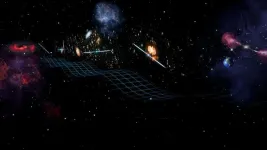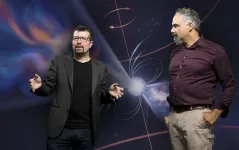(Press-News.org) Children do better at maths when music is a key part of their lessons, an analysis of almost 50 years of research on the topic has revealed.
It is thought that music can make maths more enjoyable, keep students engaged and help any ease fear or anxiety they have about maths. Motivation may be increased and pupils may appreciate maths more, the peer-reviewed article in Educational Studies details.
Techniques for integrating music into maths lessons range from clapping to pieces with different rhythms when learning numbers and fractions, to using maths to design musical instruments.
Previous research has shown that children who are better at music also do better at maths. But whether teaching music to youngsters actually improves their maths has been less clear.
To find out more, Turkish researcher Dr. Ayça Akın, from the Department of Software Engineering, Antalya Belek University, searched academic databases for research on the topic published between 1975 and 2022.
She then combined the results of 55 studies from around the world, involving almost 78,000 young people from kindergarten pupils to university students, to come up with an answer.
Three types of musical intervention were included the meta-analysis: standardised music interventions (typical music lessons, in which children sing and listen to, and compose, music), instrumental musical interventions (lessons in which children learn how to play instruments, either individually or as part of a band) and music-maths integrated interventions, in which music is integrated into maths lessons.
Students took maths tests before and after taking part in the intervention and the change in their scores was compared with that of youngsters who didn’t take part in an intervention.
The use of music, whether in separate lessons or as part of maths classes, was associated with greater improvement in maths over time.
The integrated lessons had the biggest effect, with around 73% of students who had integrated lessons doing significantly better than youngsters who didn’t have any type of musical intervention.
Some 69% of students who learned how to play instruments and 58% of students who had normal music lessons improved more than pupils with no musical intervention.
The results also indicate that music helps more with learning arithmetic than other types of maths and has a bigger impact on younger pupils and those learning more basic mathematical concepts.
Dr Akin, who carried out the research while at Turkey’s National Ministry of Education and Antalya Belek University, points out that maths and music have much in common, such as the use of symbols symmetry. Both subjects also require abstract thought and quantitative reasoning.
Arithmetic may lend itself particularly well to being taught through music because core concepts, such as fractions and ratios, are also fundamental to music. For example, musical notes of different lengths can be represented as fractions and added together to create several bars of music.
Integrated lessons may be especially effective because they allow pupils to build connections between the maths and music and provide extra opportunities to explore, interpret and understand maths.
Plus, if they are more enjoyable than traditional maths lessons, any anxiety students feel about maths may be eased.
Limitations of the analysis include the relatively small number of studies available for inclusion. This meant it wasn’t possible to look at the effect of factors such as gender, socio-economic status and length of musical instruction on the results.
Dr Akin, who is now based at Antalya Belek University, concludes that while musical instruction overall has a small to moderate effect on achievement in maths, integrated lessons have a large impact.
She adds: “Encouraging mathematics and music teachers to plan lessons together could help ease students’ anxiety about mathematics, while also boosting achievement.”
END
Combining maths with music leads to higher scores, suggests review of 50 years of research
2023-06-29
ELSE PRESS RELEASES FROM THIS DATE:
Test animals, hold your breath
2023-06-29
Kyoto, Japan -- Animal experimentation may not be a thing of the past just yet, but work on human iPS cell technology may someday grant emancipation for lab mice and other species.
Renal proximal tubules are an essential part of our kidneys' ability to reabsorb vital substances into the bloodstream, such as albumin, before the conversion to urine.
However, in order to pursue accurate testing and other applications, researchers have needed a quantitative evaluation system that simulates the function of ...
BBCube 3D: a breakthrough in semiconductor integration and data transmission
2023-06-29
A technology for the three-dimensional integration of processing units and memory, as reported by researchers from Tokyo Tech, has achieved the highest attainable performance in the whole world, paving the way to faster and more efficient computing. Named "BBCube 3D," this innovative stacked architecture achieves higher data bandwidths than state-of-the-art memory technologies, while also minimizing the energy needed for bit access.
In the present digital age, engineers and researchers keep coming up with new computer-assisted technologies that require higher data bandwidths between the processing units (or PUs, such as GPUs and CPUs) and memory chips. Some examples ...
Scientists find evidence for slow-rolling sea of gravitational waves
2023-06-29
Scientists are reporting the first evidence that our Earth and the universe around us are awash in a background of spacetime undulations called gravitational waves. The waves oscillate very slowly over years and even decades and are thought to originate primarily from pairs of supermassive black holes leisurely spiraling together before they merge.
The findings, reported in a series of papers in The Astrophysical Journal Letters, come from 15 years’ worth of observations made ...
First misinformation susceptibility test finds ‘very online’ Gen Z and millennials are most vulnerable to fake news
2023-06-29
University of Cambridge psychologists have developed the first validated “misinformation susceptibility test”: a quick two-minute quiz that gives a solid indication of how vulnerable a person is to being duped by the kind of fabricated news that floods online spaces.
The test, proven to work through a series of experiments involving over 8,000 participants taking place over two years, has been deployed by polling organisation YouGov to determine how susceptible Americans are to fake headlines.
The first survey to use the new 20-point test, called ‘MIST’ ...
Clamor of gravitational waves from universe’s merging supermassive black holes ‘heard’ for first time
2023-06-29
Following 15 years of data collection in a galaxy-sized experiment, scientists have “heard” the perpetual chorus of gravitational waves rippling through our universe for the first time — and it’s louder than expected.
The groundbreaking discovery was made by scientists with the North American Nanohertz Observatory for Gravitational Waves (NANOGrav) who closely observed stars called pulsars that act as celestial metronomes. The newly detected gravitational waves — ripples in the fabric of space-time — are by far the most powerful ever measured: They carry roughly a million times as much energy as ...
Gravitational waves from colossal black holes found using 'cosmic clocks'
2023-06-29
You can't see or feel it, but everything around you — including your own body — is slowly shrinking and expanding. It's the weird, spacetime-warping effect of gravitational waves passing through our galaxy, according to a new study by a team of researchers with the U.S. National Science Foundation's NANOGrav Physics Frontiers Center.
The findings published today in The Astrophysical Journal Letters are from the North American Nanohertz Observatory for Gravitational Waves (NANOGrav), a collaborative team of researchers from more than 50 institutions in the U.S. and abroad. The team ...
Scientists use exotic stars to tune into hum from cosmic symphony
2023-06-29
Astrophysicists using large radio telescopes to observe a collection of cosmic clocks in our Galaxy have found evidence for gravitational waves that oscillate with periods of years to decades, according to a set of papers published today in The Astrophysical Journal Letters. The gravitational-wave signal was observed in 15 years of data acquired by the North American Nanohertz Observatory for Gravitational Waves (NANOGrav) Physics Frontiers Center (PFC), a collaboration of more than 190 scientists from the US and Canada who use pulsars ...
Australian astronomers find possible ‘fingerprints’ of gravitational waves
2023-06-29
Astronomers using data collected by CSIRO’s Parkes radio telescope, Murriyang, have found their strongest evidence yet for low-frequency gravitational waves.
For nearly 20 years the Parkes Pulsar Timing Array collaboration has monitored a set of rapidly spinning stars that pulse like a lighthouse, called pulsars.
They are looking for nanosecond pulse delays caused by gravitational waves to provide further evidence for Einstein’s general theory of relativity and build on our understanding of the Universe.
By ...
Astrophysics collaboration led by Oregon State finds ‘chorus’ of gravitational waves
2023-06-29
CORVALLIS, Ore. – Gravitational waves, ripples in the fabric of time-space predicted by Albert Einstein more than a century ago, are permeating the universe at low frequencies, according to a multiyear National Science Foundation project led by Oregon State University scientists.
The findings appear in a collection of five papers authored by researchers from the NANOGrav Physics Frontier Center co-directed by Xavier Siemens, professor of physics in the OSU College of Science.
Evidence of the gravitational waves, whose oscillations are ...
CCNY professor Jacek Dmochowski breaks down science of sports betting
2023-06-29
It’s a dilemma that many a regular bettor probably faces often -- deciding when to place a sports bet. In a study entitled “A statistical theory of optimal decision-making in sports betting,” Jacek Dmochowski, Associate Professor in the Grove School of Engineering at The City College of New York, provides the answer. His original finding appears in the journal PLOS One.
“The central finding of the work is that the objective in sports betting is to estimate the median outcome. Importantly, this is not the same as the average outcome,” said Dmochowski, whose expertise ...





